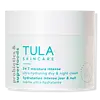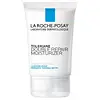What's inside
What's inside
 Key Ingredients
Key Ingredients

 Benefits
Benefits

 Concerns
Concerns

 Ingredients Side-by-side
Ingredients Side-by-side

Water
Skin ConditioningButyrospermum Parkii Butter
Skin ConditioningPropanediol
SolventGlycerin
HumectantDicaprylyl Carbonate
EmollientJojoba Esters
EmollientCamellia Japonica Seed Oil
EmollientLactococcus Ferment Lysate
Skin ConditioningGlyceryl Stearate
EmollientCetearyl Alcohol
EmollientAmmonium Acryloyldimethyltaurate/Beheneth-25 Methacrylate Crosspolymer
Emulsion StabilisingMyristyl Myristate
EmollientSqualane
EmollientPolyacrylate Crosspolymer-6
Emulsion StabilisingHyaluronic Acid
HumectantCollagen
MoisturisingHippophae Rhamnoides Oil
EmollientArgania Spinosa Kernel Oil
EmollientLinoleic Acid
CleansingLinolenic Acid
CleansingHydrolyzed Rice Protein
Skin ConditioningLactobacillus
Skin ConditioningLactobacillus Ferment
Skin ConditioningCichorium Intybus Root Extract
MaskingCitrullus Lanatus Fruit Extract
Skin ConditioningPyrus Malus Fruit Extract
Skin ConditioningCurcuma Longa Root Extract
MaskingLactic Acid
BufferingVaccinium Angustifolium Fruit Extract
Skin ProtectingBeta Vulgaris Root Extract
Skin ConditioningTocopheryl Acetate
AntioxidantInulin
Skin ConditioningPolymnia Sonchifolia Root Juice
Skin ConditioningAlpha-Glucan Oligosaccharide
CleansingAscorbyl Palmitate
AntioxidantLens Esculenta Fruit Extract
Skin ConditioningSodium PCA
HumectantLeuconostoc/Radish Root Ferment Filtrate
AntimicrobialButylene Glycol
HumectantCandelilla/Jojoba/Rice Bran Polyglyceryl-3 Esters
EmulsifyingCaprylyl Glycol
EmollientCetearyl Olivate
Maltodextrin
AbsorbentPentylene Glycol
Skin ConditioningPotassium Sorbate
PreservativeSodium Benzoate
MaskingSodium Chloride
MaskingSodium Phytate
Polysorbate 60
EmulsifyingSodium Stearoyl Lactylate
EmulsifyingParfum
MaskingWater, Butyrospermum Parkii Butter, Propanediol, Glycerin, Dicaprylyl Carbonate, Jojoba Esters, Camellia Japonica Seed Oil, Lactococcus Ferment Lysate, Glyceryl Stearate, Cetearyl Alcohol, Ammonium Acryloyldimethyltaurate/Beheneth-25 Methacrylate Crosspolymer, Myristyl Myristate, Squalane, Polyacrylate Crosspolymer-6, Hyaluronic Acid, Collagen, Hippophae Rhamnoides Oil, Argania Spinosa Kernel Oil, Linoleic Acid, Linolenic Acid, Hydrolyzed Rice Protein, Lactobacillus, Lactobacillus Ferment, Cichorium Intybus Root Extract, Citrullus Lanatus Fruit Extract, Pyrus Malus Fruit Extract, Curcuma Longa Root Extract, Lactic Acid, Vaccinium Angustifolium Fruit Extract, Beta Vulgaris Root Extract, Tocopheryl Acetate, Inulin, Polymnia Sonchifolia Root Juice, Alpha-Glucan Oligosaccharide, Ascorbyl Palmitate, Lens Esculenta Fruit Extract, Sodium PCA, Leuconostoc/Radish Root Ferment Filtrate, Butylene Glycol, Candelilla/Jojoba/Rice Bran Polyglyceryl-3 Esters, Caprylyl Glycol, Cetearyl Olivate, Maltodextrin, Pentylene Glycol, Potassium Sorbate, Sodium Benzoate, Sodium Chloride, Sodium Phytate, Polysorbate 60, Sodium Stearoyl Lactylate, Parfum
Water
Skin ConditioningGlycerin
HumectantSqualane
EmollientDimethicone
EmollientZea Mays Starch
AbsorbentNiacinamide
SmoothingAmmonium Polyacryloyldimethyl Taurate
Emulsion StabilisingMyristyl Myristate
EmollientStearic Acid
CleansingCeramide NP
Skin ConditioningPotassium Cetyl Phosphate
EmulsifyingGlyceryl Stearate Se
EmulsifyingSodium Hydroxide
BufferingMyristic Acid
CleansingPalmitic Acid
EmollientCapryloyl Glycine
CleansingCaprylyl Glycol
EmollientXanthan Gum
EmulsifyingWater, Glycerin, Squalane, Dimethicone, Zea Mays Starch, Niacinamide, Ammonium Polyacryloyldimethyl Taurate, Myristyl Myristate, Stearic Acid, Ceramide NP, Potassium Cetyl Phosphate, Glyceryl Stearate Se, Sodium Hydroxide, Myristic Acid, Palmitic Acid, Capryloyl Glycine, Caprylyl Glycol, Xanthan Gum
 Reviews
Reviews

Ingredients Explained
These ingredients are found in both products.
Ingredients higher up in an ingredient list are typically present in a larger amount.
Caprylyl Glycol is a humectant and emollient, meaning it attracts and preserves moisture.
It is a common ingredient in many products, especially those designed to hydrate skin. The primary benefits are retaining moisture, skin softening, and promoting a healthy skin barrier.
Though Caprylyl Glycol is an alcohol derived from fatty acids, it is not the kind that can dry out skin.
This ingredient is also used as a preservative to extend the life of products. It has slight antimicrobial properties.
Learn more about Caprylyl GlycolGlycerin is already naturally found in your skin. It helps moisturize and protect your skin.
A study from 2016 found glycerin to be more effective as a humectant than AHAs and hyaluronic acid.
As a humectant, it helps the skin stay hydrated by pulling moisture to your skin. The low molecular weight of glycerin allows it to pull moisture into the deeper layers of your skin.
Hydrated skin improves your skin barrier; Your skin barrier helps protect against irritants and bacteria.
Glycerin has also been found to have antimicrobial and antiviral properties. Due to these properties, glycerin is often used in wound and burn treatments.
In cosmetics, glycerin is usually derived from plants such as soybean or palm. However, it can also be sourced from animals, such as tallow or animal fat.
This ingredient is organic, colorless, odorless, and non-toxic.
Glycerin is the name for this ingredient in American English. British English uses Glycerol/Glycerine.
Learn more about GlycerinMyristyl Myristate is created from the fatty acids of myristyl alcohol and myristic acid. In skincare, it is an emollient and texture enhancer.
On its own, this ingredient has a comedogenicity index of 5/5. This means it has the potential to clog pores. When diluted with cetyl alcohol or propylene glycol, the comedogenicity will decrease.
This ingredient may not be Malassezia folliculitis, or fungal-acne safe.
Nutmeg, palm kernel oil, and coconut oil all contain this ingredient naturally.
Learn more about Myristyl MyristateSqualane is an emollient that helps the skin hold onto moisture. It's an oily liquid that occurs naturally in certain types of fish and plant oils.
Because squalane boosts hydration in the skin, it also comes with plenty of benefits: it is an antioxidant and can help fight free radicals and skin damage. Squalane is also found to have a detoxifying effect when applied.
Squalane comes from squalene, which occurs naturally within the sebum of our skin. It is one of the oils our skin produces to keep itself hydrated. Squalane is the hydrogenated version of squalene and has a longer shelf life.
Research shows that squalane is non-irritating (even at 100% concentration).
In general, it's a fantastic ingredient. It does a great job at hydrating the skin, and it's suitable for those with sensitive skin.
The source of squalane may impact malassezia / fungal acne. This is because olive oil derived squalane can contain impurities such as fatty acids and plant waxes. Sugarcane derived squalane is recommended for anyone with malassezia concerns.
Is squalane vegan?
This depends on the source. Squalane can be derived from both plants and animals. Most squalane used in skincare comes from plants.
Please note: the source of squalane is only known if disclosed by the brand. We recommend reaching out to the brand if you have any questions about their squalane.
Read more about squalene with an "e".
Is squalane an oil?
Squalane is often called an oil, but it’s technically not; it’s a hydrocarbon, meaning it’s only made of carbon and hydrogen, unlike true oils which are triglycerides made of fatty acids and glycerol.
The term “oil-free” isn’t regulated, so companies can define it however they want. Some exclude all oils, while others just avoid mineral oil or comedogenic oils.
While some people avoid oils thinking they cause breakouts, the right kind of oil (or oil-like ingredient like squalane) can actually help balance and hydrate your skin. It’s worth testing out simple oils or squalane to see what works best for your skin.
Learn more about SqualaneWater. It's the most common cosmetic ingredient of all. You'll usually see it at the top of ingredient lists, meaning that it makes up the largest part of the product.
So why is it so popular? Water most often acts as a solvent - this means that it helps dissolve other ingredients into the formulation.
You'll also recognize water as that liquid we all need to stay alive. If you see this, drink a glass of water. Stay hydrated!
Learn more about Water